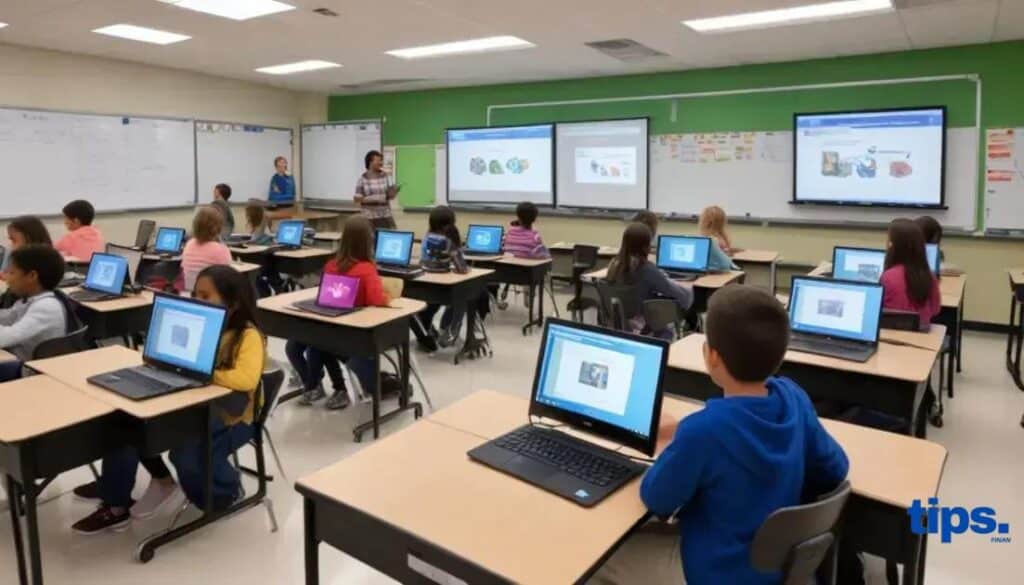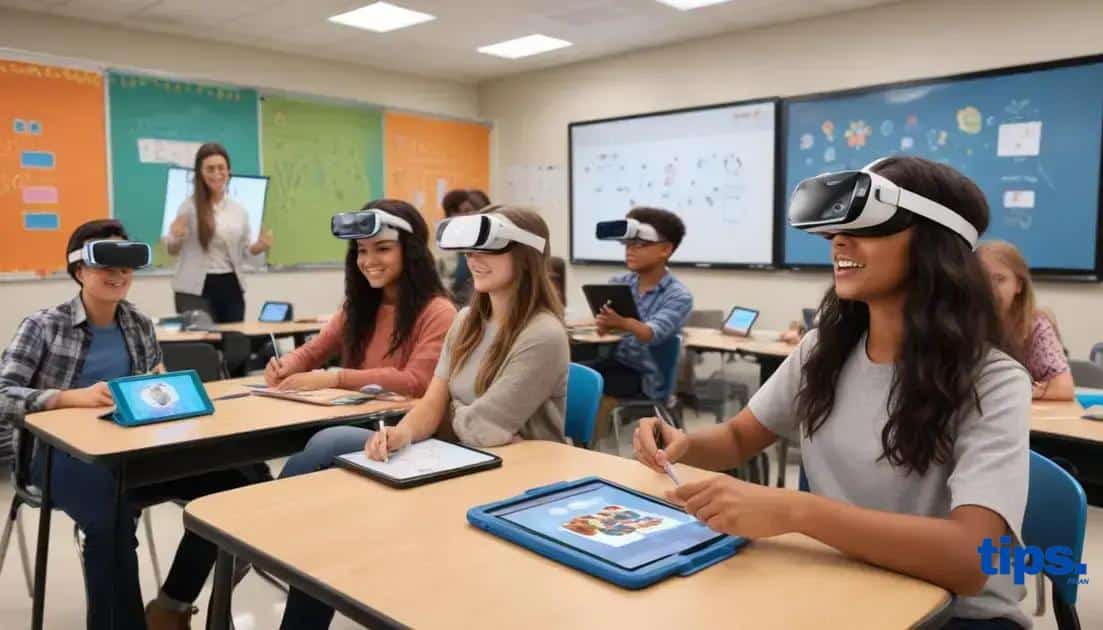Technology in classrooms: transforming education

Anúncios
Technology in classrooms enhances student engagement and learning through interactive tools like smartboards, online platforms, and educational apps, creating a more dynamic and personalized educational experience.
Technology in classrooms has the potential to reshape the learning landscape. Imagine a space where students are fully engaged, using the latest tools and resources to enhance their educational experience. Interested in how this transition unfolds?
Anúncios
The evolution of technology in classrooms
The evolution of technology in classrooms has transformed how educators teach and students learn. With the advancements in digital tools, classrooms have become more interactive and engaging.
Initially, education relied heavily on traditional methods, like textbooks and chalkboards. Today, technology has introduced a variety of resources, such as tablets, laptops, and online platforms that facilitate dynamic learning experiences.
Key Milestones in Classroom Technology
- The introduction of computers in classrooms during the 1980s.
- The rise of the internet in the 1990s, providing access to vast resources.
- The development of interactive whiteboards and educational apps in the 2000s.
These changes not only make learning more accessible but also help students develop essential skills for the digital age. Educators can now personalize learning through technology, catering to different learning styles and paces.
Anúncios
To learn more about the history and impact of educational technology, check out the resources from Edutopia.
| Aspect | Description | Example/Tool |
|---|---|---|
| Evolution | Technology changed how we teach and learn | From chalkboards to tablets |
| Personalized Learning | Tailors lessons to individual needs | Adaptive platforms, AI tools |
| Engagement | Boosts student interest and participation | Games, quizzes, simulations |
| Challenges | Barriers to effective use of tech | Digital divide, lack of training |
| Interactive Tools | Make learning more hands-on | Smartboards, Kahoot!, VR |
| Teacher Role | Facilitate and guide tech use | Curate tools, encourage teamwork |
| Future Trends | Emerging innovations in EdTech | AI, gamification, AR/VR |
| Real-Life Examples | Tech used effectively in schools | Google Classroom, Khan Academy |
Benefits of integrating technology in education
Integrating technology in education offers many benefits that enhance learning outcomes and engagement among students. These tools provide innovative ways to present information and encourage exploration.
When students interact with technology, they tend to show greater enthusiasm for learning. Benefits can include:
- Personalized learning: Technology allows educators to tailor lessons to meet individual student needs, promoting a better understanding.
- Access to vast resources: The internet provides a wealth of information, enabling students to explore topics in-depth and from various perspectives.
- Collaboration and communication: Tools like online discussion boards and project management apps improve teamwork among students, making group assignments more effective.
Additionally, technology supports critical thinking and problem-solving skills, essential for success in modern society. Educators can use platforms like Common Sense Education to learn more about integrating these tools effectively in their classrooms.
Challenges faced by teachers with technology
Teachers often encounter several challenges when integrating technology into their classrooms. These obstacles can hinder the effectiveness of educational tools and methods.
One significant challenge is the digital divide, where not all students have equal access to devices and internet connectivity. This can lead to disparities in learning opportunities.
Additionally, many educators feel unprepared to effectively use technology in their teaching. Challenges include:
- Lack of training: Teachers may not receive sufficient professional development on how to use new technologies effectively.
- Time constraints: The demands of teaching can leave little time for exploring new tools or updating teaching methods.
- Resistance to change: Some educators may be hesitant to adopt technology due to comfort with traditional teaching methods.
Despite these challenges, many resources can assist teachers in overcoming obstacles. For example, sites like Teaching Channel offer valuable materials and videos to help educators navigate technology integration.
Innovative tools for interactive learning

Innovative tools for interactive learning are changing the way students engage with content. These tools help create a more dynamic classroom experience.
Various technologies support active learning by encouraging student participation and collaboration. Some popular tools include:
- Interactive whiteboards: These allow teachers to display information interactively, making lessons more engaging.
- Education apps: Apps like Kahoot! and Quizlet help students learn through games and quizzes.
- Virtual reality (VR): VR can transport students to different environments, enhancing their understanding of complex subjects.
By using these innovative tools, educators can cater to diverse learning styles, making lessons more effective. For further insights into interactive learning tools, consider visiting EdTech Magazine.
How technology fosters student engagement
Technology plays a vital role in fostering student engagement in the classroom. By integrating various tools and resources, educators can create an interactive learning environment.
One key aspect of technology in education is its ability to provide immediate feedback. This helps students understand their progress and areas for improvement. For example, online quizzes allow quick assessments that keep students engaged.
Moreover, technology offers diverse learning experiences. Students can:
- Participate in online discussions: Platforms like forums and chat rooms encourage collaboration and exchange of ideas.
- Access multimedia resources: Videos, podcasts, and simulations enhance understanding of complex subjects.
- Engage in hands-on learning: Virtual labs and interactive simulations allow students to experiment in a safe environment.
For more insights into how technology can boost engagement, check out resources from Edutopia.
The role of teachers in a tech-savvy classroom
In a tech-savvy classroom, teachers play a crucial role in guiding student learning and effectively integrating technology into their lessons. Their responsibility has evolved with the introduction of digital tools.
Teachers are not just instructors; they are facilitators and mentors. With technology, their roles include:
- Curating resources: Selecting and providing access to the best digital tools and content available for learning.
- Encouraging collaboration: Using technology to promote teamwork among students through group projects and discussions.
- Supporting diverse learning styles: Adapting lessons using various formats, such as videos, interactive simulations, and games.
Additionally, teachers must continuously update their own skills to keep up with new technologies. They can find professional development resources and community support from sites like TeachThought.
Future trends in educational technology
The future trends in educational technology are shaping how learning environments will function. As technology continues to evolve, schools and educators are adopting innovative solutions.
One significant trend is the use of artificial intelligence (AI) to personalize learning experiences. AI can analyze data to adjust lesson plans based on individual student needs. Other trends to watch include:
- Blended learning: Combining traditional teaching methods with online resources allows for a more flexible approach.
- Gamification: Integrating game elements into lessons increases student motivation and engagement.
- Augmented reality (AR) and virtual reality (VR): These technologies create immersive learning experiences, allowing students to explore complex subjects in an interactive way.
For more insights on educational technology trends, visit Education Corner.
Real-life examples of technology in classrooms

Real-life examples of technology in classrooms showcase how innovative tools can enhance educational experiences and outcomes. Many schools are adopting technology to promote engagement and improve learning.
One notable example is the use of smartboards. Teachers use these interactive displays to present lessons, encourage participation, and foster collaboration among students.
Another effective tool is online learning platforms. For instance:
- Google Classroom: This platform allows educators to create, distribute, and grade assignments digitally, streamlining workflow.
- Khan Academy: Offers video lessons and practice exercises, giving students a chance to learn at their own pace.
- Quizizz: A fun quiz tool that enhances student engagement during lessons.
These tools demonstrate the positive impact of technology on education. Schools can explore more examples through resources like Edutopia.
Embracing technology in education
The integration of technology in classrooms is transforming education for the better. Tools like smartboards, online platforms, and interactive resources are making learning more engaging and accessible for every student.
As educators continue to explore new technologies, it is essential to focus on their implementation in ways that promote collaboration, personalized learning, and critical thinking.
By understanding and applying these tools effectively, teachers can create a rich learning environment that prepares students for a future where technology plays a significant role. Therefore, embracing these changes will not only enhance current teaching methods but also empower the next generation of learners.
FAQ – Frequently Asked Questions about Technology in Classrooms
What are the benefits of using technology in education?
Using technology in education enhances student engagement, supports personalized learning, and provides access to a wealth of resources.
How can teachers effectively integrate technology into their lessons?
Teachers can integrate technology by selecting appropriate tools, providing hands-on experiences, and encouraging collaboration through online platforms.
What role do students have in a tech-savvy classroom?
Students play an active role by participating in interactive lessons, using digital resources for research, and collaborating on projects with their peers.
Are there risks involved with using technology in classrooms?
Yes, some risks include screen time fatigue, distractions, and the digital divide, where not all students have equal access to technology.





